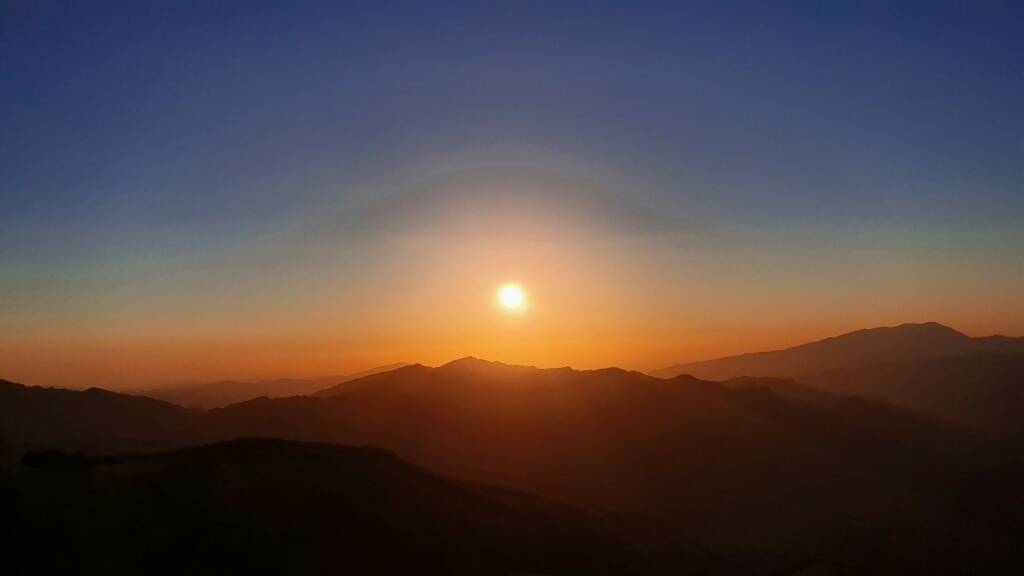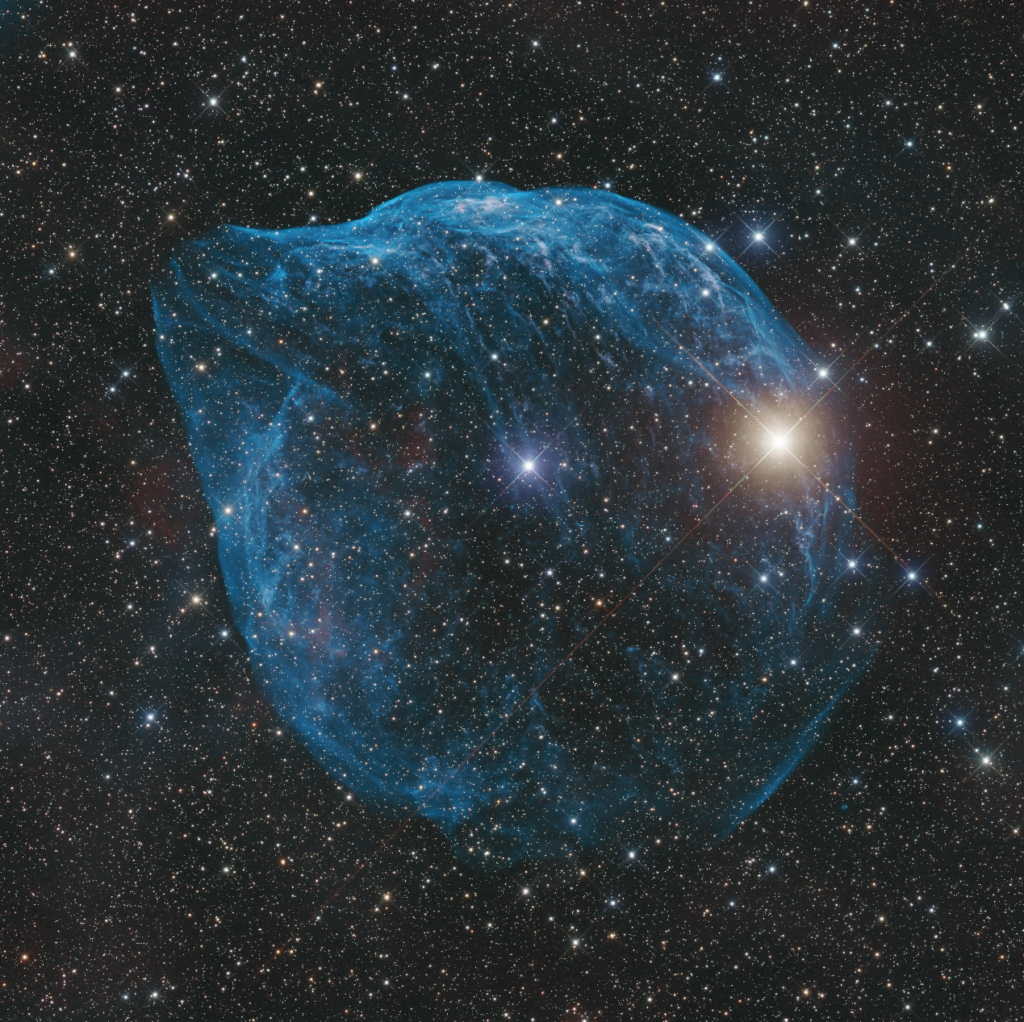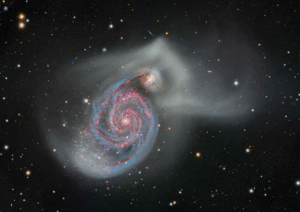
Discovery of the M31 [OIII] emission arc
Recently, a major discovery by an international team of amateur astronomers and scientists has become a huge online hit, and this new discovery is just located in one of the

Hello Simone, thanks for accepting our interview invitation. Congratulations on winning the ASIWEEK competition in week #19/2024!

Hello everybody, my name is Simone Curzi and I was born 42 years ago in San Benedetto del Tronto, the pearl of the Riviera delle Palme, a renowned Italian tourist area on the Adriatic coast. I’m a banker with a great passion for astronomy, nature, and enjoying good food and drink!!
Thanks to my job, I’ve had the opportunity to live in numerous Italian and European cities. However, for the past few years, I’ve returned to my homeland where I live with my wonderful and young partner Roberta, and my son Alessandro.
Once, when I was a child, I think I was 5 or 6 years old, I stayed up late to watch “Aliens” on TV. Although the movie wasn’t suitable for a child my age, it didn’t scare me; instead, it sparked a great curiosity in me about space and the possibility of life beyond Earth. For many years, this passion and curiosity toward the unknown found expression only in documentaries and science fiction productions. It wasn’t until I started university that I had a roommate who was studying physics, and although I was enrolled in economics studies, I began attending astrophysics classes with him.
Many years passed before my passion took another step forward. Indeed, it was only four years ago, thanks to a small sum of money I had saved for a ceremony that ended up being canceled, that I bought my first telescope, a C 9.25. From there, my journey into astrophotography began.
Many aspects bind me to astrophotography. Firstly, it’s a discipline that inseparably intertwines science and art, reflecting my soul, torn between passions often in contrast with each other. I love spending hours outdoors in places often untouched by human hands to capture my signal, just as I enjoy spending time in front of the computer studying new techniques to process my shots.
Unfortunately, the Italian sky is one of the most affected by light pollution in Europe and the world. Truly dark areas are few and often difficult to reach. My region, Marche, is not exempt from light pollution, especially along the coast. My small observatory is located under an acceptable sky (Bortle 4/5), so I often take advantage of this issue to organize trips outside the city in search of darker skies.


It had been a long time since I wanted to tackle the Witch Head Nebula; it’s a subject that has always fascinated me deeply. During the planning of the shot, I decided to include Rigel in the frame, even though I was aware that it would significantly increase the difficulty of acquiring and processing the exposures. Despite spending a lot of time planning, shooting, and processing the photo, I’m not fully satisfied with the result. It’s certainly a beautiful photo that has helped me grow in experience and has been well-received, but I believe I can do even better. I’ll try the subject again next year. After all, the beauty of astrophotography lies in that sense of satisfaction you feel with each shot, appreciating your progress.

During these four years, I’ve assembled a nice set of equipment that I’m very proud of. My first telescope, the C9.25, is mainly used for visual observation, although lately, I’ve been optimizing it for planetary photography, an area where I want to take my next steps. My primary instruments for deep sky imaging are a Sharpstar 94EDPH and a Redcat 51, which have given me a lot of satisfaction; I particularly love wide-field views. Additionally, I own a 72ED and an FMA180, which I primarily use as guide telescopes. I also have a lot of ZWO ASI equipment, of which I’m a very happy customer: two ASIAir+, three EAFs, one 2-inch EFW, and several astronomical cameras, which I’ll talk about later.

In producing a DSO image, I don’t believe there are easy or difficult phases. It’s a sequence of steps, all important and deserving of maximum attention, starting from planning, moving to acquisition, and reaching processing, without neglecting phases that may seem marginal, such as equipment maintenance or simple cable management. The ASIAIR+ has helped me tremendously with my work, both in planning the shot (planetary and mosaic modes are two functions I love) and in acquisition, by allowing me to connect and control all my equipment in a small yet powerful hub. This is beneficial not only when shooting from my fixed location but especially when I’m traveling in search of darker skies.
I don’t have a true favorite object; I love all the objects I’ve captured and appreciate and desire even more those I haven’t had the pleasure of capturing yet. Among those already captured, there’s one I’ve photographed multiple times, with which I like to test my new equipment and assess my progress: the Dark Shark. It’s a nebula as beautiful as it is challenging to tackle, both in acquisition and processing. I still remember my first attempt: it was a real disaster, I wasn’t ready for a subject like that yet. But then I tried again several times, and even though I haven’t reached the level I desire yet, the progress I’ve made is evident, and I’m proud of it.

As I mentioned before, sometimes I venture into remote and isolated places in search of dark skies, and although I can’t say I’ve had memorable experiences, on a couple of occasions, I was truly scared. Once, while I was inside the Gargano Reserve in Puglia, I was charged by a group of wild boars, but I didn’t run away because I was too afraid they might damage my equipment. Instead, I tried to scare them off by shouting like crazy, and luckily it worked. On another occasion, I was staying in a refuge on Monte Vettore with my partner, and in the middle of the night, while I was outside taking shots, I had the feeling of being watched. I started looking around and immediately noticed many shiny dots reflecting the light from my torch. It didn’t take long to realize that the dots were nothing but the eyes of a pack of wolves. That time, fear won, and I locked myself in the refuge until dawn!

I recently joined the ShaRA Team (Shared Remote Astrophotography), a unique opportunity for me to connect and collaborate with world-class astrophotographers and work with top-notch equipment under the best dark skies. Also, recently, I launched my YouTube channel “Astrophotography_Channel,” where I try to share the latest updates on processing techniques and Pixinsight with the Italian community. Lastly, with my partner, I’m working on a blog “Traveling under the stars” that combines my passion for astrophotography with our love for nature, travel, and good food.

To those starting with astrophotography today, I recommend joining an association or connecting with a friend who already practices this beautiful passion and can guide them in the initial steps. They should avoid spending too much money on a myriad of instruments, starting with something simple and learning to master it as best as possible. Lastly, the most important thing is to have fun, and not worry too much about the results. Those improve with experience.

To streamline the learning curve, I embraced the entire ZWO ASI ecosystem from the outset, enticed by the prospect of connecting and controlling everything through an ASIAIR. Therefore, even for cameras, I turned to your company. My first camera was a 294 mc pro, which, in my opinion, was an excellent tool to start with and provided decent results from my experiences. As my passion grew, so did my desire to improve, leading me to switch to a monochrome setup by acquiring a 2600mm pro. This immediately became my primary tool, featuring a fantastic sensor. Recently, I also acquired the OSC version for outdoor trips where I don’t have time to gather individual channels. To guide, I rely on two 120mm cameras that perform their job reliably.
As I’ve emphasized multiple times, I’m genuinely satisfied as a ZWO ASI customer. I have the “habit” of speaking my mind, and I would have done so in this case too if I felt it was appropriate. I eagerly await your rotator and hope its management is integrated into the planetarium, thus allowing for immediate and simple framing, in true ZWO style. If you’re interested, I would be delighted to test it and provide honest feedback to the company and the entire astrophotography community. Additionally, I hope there’s a panel for flats in your plans, adaptable to multiple configurations. I’m a satisfied yet demanding user, and for my setup, I want the best possible solution!

Thank you for choosing my image for this opportunity to introduce myself, and above all, for your work that has allowed me to discover this fantastic world that brings me so much satisfaction and the desire to improve.
Clear skies to all.
Please follow me on:
https://www.instagram.com/simone_curzi_skylover/
https://www.facebook.com/DoctorWeed/

Recently, a major discovery by an international team of amateur astronomers and scientists has become a huge online hit, and this new discovery is just located in one of the

To most people, this might just look like a pretty picture. But to astrophotographer Cem Diken, it’s the result of three years of chasing a nearly invisible ghost in the

I was born in Guadalajara, I’m 38 years old, a musician, communications and electronics engineer, and president of the Guadalajara Astronomical Society A.C. since 2020. First Contact with Astronomy Since

This stunning collaborative project comes from astrophotographers Alex Linde and Thomas Hansson, who joined forces across borders to photograph the Whirlpool Galaxy from Sweden, Poland, and Texas, USA. Thomas traveled across


“Two thoughts immediately crossed my mind—the vastness of the cosmos, and that I could also create images like the ones that inspired me.” ” If you spend more time debugging than